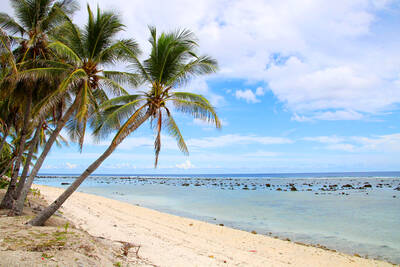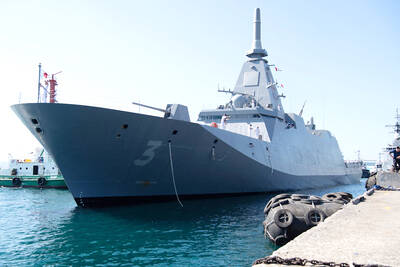Canada has announced an expedition to search for British explorer Sir John Franklin’s two ships, trapped in Arctic ice more than 160 years ago.
“The Franklin Expedition is a key part of Canada’s history of Arctic exploration. As Canada is once again asserting ourselves and protecting our sovereignty in the High Arctic, this expedition will provide important new information and will add to the body of research on the fate of these ships,” Canada’s Environment Minister John Baird said.
“An actual discovery of these wrecks would offer unprecedented information on the exploration of Canada’s north and the discovery of the Northwest Passage — a critical piece of our shared history and important to present and future generations,” he said.
The expedition is to begin tomorrow aboard the Canadian Coast Guard ice-breaker Sir Wilfrid Laurier, Baird and Fisheries and Oceans Minister Loyola Hearn announced.
Expedition leader Robert Grenier of Canada’s Underwater Archeological Service called the two vessels “mythic ships” on a par with the Titanic.
Franklin’s ill-fated expedition is credited with discovering the Northwest Passage, which Grenier called a “maritime Silk Road to China and Japan,” linking the northern Atlantic and Pacific oceans.
The British explorer and some 130 men set sail aboard the HMS Erebus and the HMS Terror in 1845, and were never seen again.
Numerous search parties over the next decades and into the 20th century pieced together the fate of the expedition, whose members apparently perished from exposure, starvation, disease and possibly lead poisoning from eating food from poorly sealed tin cans.
The two ships, frozen in ice northwest of King William Island, have never been found.
Canada’s expedition, which will be undertaken during the August-September period over each of the next three years, should also contribute to mapping the uncharted waters of the strategic zone, the Canadian ministers said.
Interest in the Northwest Passage has grown as climate change has melted Arctic ice, making the route navigable in the northern hemisphere summer.
Canada asserts that the strategic passage, winding among islands of its Northwest Territories, is part of its territorial waters, while other countries, including the US, consider them international waters.
The sudden interest in the two vessels coincides with Ottawa’s desire to affirm its sovereignty in the Arctic, John Geiger, co-author of a book about the Franklin expedition, recently wrote in the Globe and Mail newspaper.
Canada’s conservative government announced last year that it was increasing its military capacity in the Arctic, including creating a deep water port in Nanisivik, at the northern tip of Baffin Island.
Canada last week said it had scientific proof of its territorial claims over a vast portion of the Arctic, amid debate between northern nations over sovereignty in the oil-rich region.
Natural Resources Minister Gary Lunn said joint research with Denmark had found that the undersea Lomonosov Ridge is attached to the North American and Greenland plates, directly challenging a Russian claim.
Five countries that border the Arctic Ocean — Canada, Denmark, Norway, Russia and the US — dispute the sovereignty of the region’s waters, and potential mineral riches have heightened tensions.
The US Geological Survey believes that the Arctic region contains 90 billion barrels of oil.
The UN Convention on the Law of the Sea stipulates that any coastal state can claim territory 200 nautical miles from their shoreline and exploit the natural resources within that zone.
But nations must provide scientific proof of the natural extension of the continental plate.

Nauru has started selling passports to fund climate action, but is so far struggling to attract new citizens to the low-lying, largely barren island in the Pacific Ocean. Nauru, one of the world’s smallest nations, has a novel plan to fund its fight against climate change by selling so-called “Golden Passports.” Selling for US$105,000 each, Nauru plans to drum up more than US$5 million in the first year of the “climate resilience citizenship” program. Almost six months after the scheme opened in February, Nauru has so far approved just six applications — covering two families and four individuals. Despite the slow start —

YELLOW SHIRTS: Many protesters were associated with pro-royalist groups that had previously supported the ouster of Paetongtarn’s father, Thaksin, in 2006 Protesters rallied on Saturday in the Thai capital to demand the resignation of court-suspended Thai Prime Minister Paetongtarn Shinawatra and in support of the armed forces following a violent border dispute with Cambodia that killed more than three dozen people and displaced more than 260,000. Gathered at Bangkok’s Victory Monument despite soaring temperatures, many sang patriotic songs and listened to speeches denouncing Paetongtarn and her father, former Thai prime minister Thaksin Shinawatra, and voiced their backing of the country’s army, which has always retained substantial power in the Southeast Asian country. Police said there were about 2,000 protesters by mid-afternoon, although

MOGAMI-CLASS FRIGATES: The deal is a ‘big step toward elevating national security cooperation with Australia, which is our special strategic partner,’ a Japanese official said Australia is to upgrade its navy with 11 Mogami-class frigates built by Japan’s Mitsubishi Heavy Industries, Australian Minister for Defence Richard Marles said yesterday. Billed as Japan’s biggest defense export deal since World War II, Australia is to pay US$6 billion over the next 10 years to acquire the fleet of stealth frigates. Australia is in the midst of a major military restructure, bolstering its navy with long-range firepower in an effort to deter China. It is striving to expand its fleet of major warships from 11 to 26 over the next decade. “This is clearly the biggest defense-industry agreement that has ever

DEADLY TASTE TEST: Erin Patterson tried to kill her estranged husband three times, police said in one of the major claims not heard during her initial trial Australia’s recently convicted mushroom murderer also tried to poison her husband with bolognese pasta and chicken korma curry, according to testimony aired yesterday after a suppression order lapsed. Home cook Erin Patterson was found guilty last month of murdering her husband’s parents and elderly aunt in 2023, lacing their beef Wellington lunch with lethal death cap mushrooms. A series of potentially damning allegations about Patterson’s behavior in the lead-up to the meal were withheld from the jury to give the mother-of-two a fair trial. Supreme Court Justice Christopher Beale yesterday rejected an application to keep these allegations secret. Patterson tried to kill her